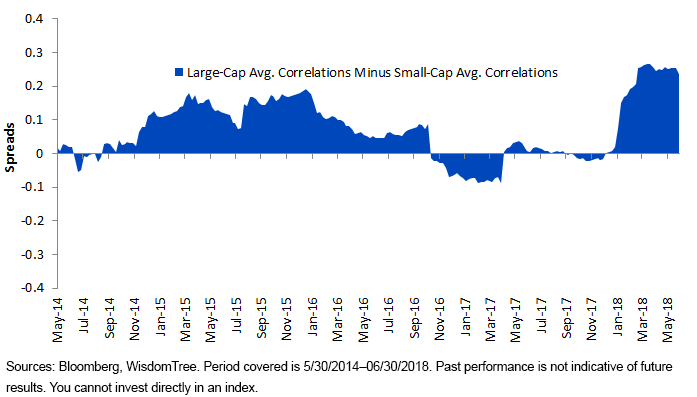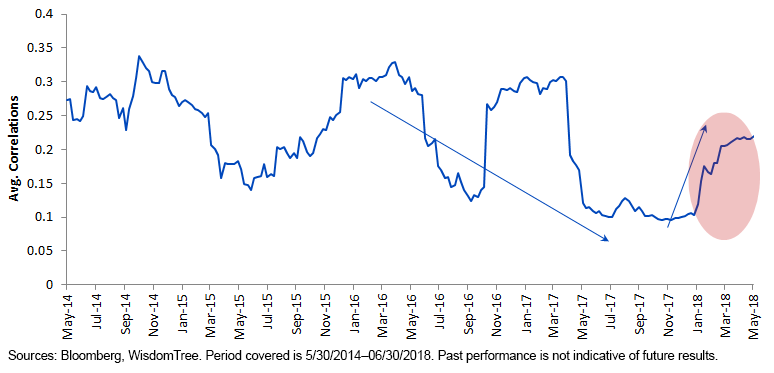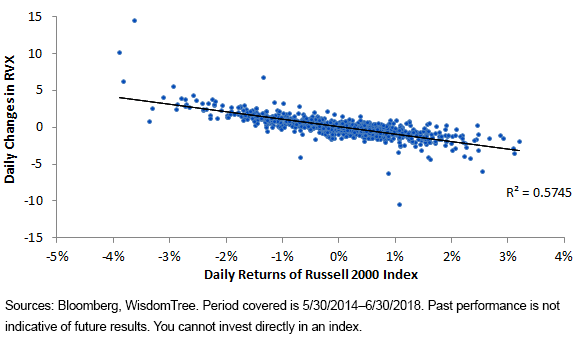Idiosyncratic Small-Cap Stocks: How to Manage Volatility


A fundamental reason people invest in small caps is their potential for better returns over longer periods. Small caps as an asset class tend to be more growth oriented, and thus investors may stand to gain more from allocating to small caps. However, higher volatility is inherent to U.S. small caps too.
In this blog post, I will examine the idiosyncratic nature of small caps by looking at their correlation profile and show how small-cap companies are less correlated to each other than they are to large caps. I will then highlight key risks of allocating to small caps in the current market cycle and, finally, how investors can potentially lower that risk.
Question 1: Idiosyncratic Behavior of Small Caps—Is It an Asset or Liability?
Small-cap companies, when compared with large caps, are typically less connected with global supply chains and are more localized. Thus, small caps as an asset class behave in a more individualistic or idiosyncratic manner. To illustrate this, the figure below plots the spread between the correlations of large- and small-cap companies in the U.S. For large caps I have taken the average of all pair-wise correlations across S&P 500 Index stocks; similarly, for small caps I have taken the average pair-wise correlation across Russell 2000 Index companies. The spread plotted below is the monthly average large-cap correlation minus the average small-cap correlation at every point in time.
Small Caps Offer Better Diversification

In recent years, this spread was positive nearly 80% of the time, meaning that correlations within the large-cap universe were higher than correlations among small-cap stocks 80% of the time. This implies a random portfolio of small caps acted more in an idiosyncratic manner than a random portfolio of large-caps stocks. This raises a key question: Is this behavior an asset or a liability?
In my opinion it is both. Smart stock selection that makes the right bets can lead to winners in small caps that potentially outperform even in a declining market. Similarly, an unwise selection can get concentrated in losers that may detract even in surging markets. Thus, this behavior of small caps is both an asset and a liability. It is no surprise, therefore, that even after offering higher diversification, small caps are more volatile as an asset class!
Question 2: Where Are the Correlations of Small Caps in the Current Cycle?
I recently wrote about how a recent spike in correlations as a result of tightening in liquidity by central banks globally has been feeding volatility. These rising correlations are also evident among small caps.
Recent Spike in Correlations in Small Caps

As we enter into a liquidity-tightening regime, I expect correlations in small caps are likely to stay higher. This means that although, on a relative basis, picking winners and losers in small caps can still meaningfully affect your portfolio, reducing volatility only through stock selection is going to be challenging.
Question 3: How Can I Mitigate the Volatility of Small-Cap Allocation in the Current Cycle?
One way of avoiding extra volatility is by continuously improving stock selection. Another way could be getting on the other side and selling small-cap volatility itself through option strategies.
A measure of the market's expectation of future volatility in small caps is the Cboe Russell 2000 VIX Index (RVX). The figure below plots day-to-day changes in RVX on the y axis against daily returns of the Russell 2000 Index on the x axis. What stands out is a very strong negative relationship between RVX and daily returns of the Russell 2000 Index. Days with negative or lower returns of the Russell 2000 are accompanied by positive changes in RVX.
Strong Negative Relationship between Russell 2000 Returns vs. RVX Changes

Benefiting from this negative relationship has not been very easy because the RVX is just an index calculation and is not directly traded.
WisdomTree has pioneered launching put-writing strategies in an exchange-traded fund wrapper and has recently focused on the small-cap volatility premium.
Earlier this year, we launched our WisdomTree Cboe Russell 2000 PutWrite Strategy Fund (RPUT) to follow up on a similar strategy designed around the S&P 500.
RPUT indirectly benefits from this negative relationship between RVX and the Russell 2000 Index. It collects volatility by selling monthly at-the-money options on the Russell 2000 Index, generating a monthly income stream. Option premiums are priced based on market expectation of future or implied volatility. When drawdowns are more volatile, the RVX goes up and the more option premium there is from selling options in RPUT.
It is important to emphasize here that RPUT is completely cash-collateralized and there is no leverage.
Conclusion and Implementation
In my view, the idiosyncratic properties of small caps have a tremendous potential upside for small-cap investors. At the same time, market forces in the current cycle are making it harder to avoid volatility through stock selection only. With this in mind, WisdomTree’s RPUT provides what I believe is an effective way to reduce downside risk in uncertain months by generating extra income that is directly proportional to prevailing volatility levels.
For those interested, here is a deeper dive on risk-return profile of this strategy.
Important Risks Related to this Article
There are risks associated with investing, including possible loss of principal. The Fund will invest in derivatives, including Russell 2000 Index put options (“RUT Puts”). Derivative investments can be volatile, and these investments may be less liquid than securities, and more sensitive to the effects of varied economic conditions. The value of the RUT Puts in which the Fund invests is partly based on the volatility used by market participants to price such options (i.e., implied volatility). The options values are partly based on the volatility used by dealers to price such options, so increases in the implied volatility of such options will cause the value of such options to increase, which will result in a corresponding increase in the liabilities of the Fund and a decrease in the Fund’s NAV. Options may be subject to volatile swings in price influenced by changes in the value of the underlying instrument. The potential return to the Fund is limited to the amount of option premiums it receives; however, the Fund can potentially lose up to the entire strike price of each option it sells. Due to the investment strategy of the Fund, it may make higher capital gain distributions than other ETFs. Please read the Fund’s prospectus for specific details regarding the Fund’s risk profile.
Diversification does not eliminate the risk of experiencing investment losses.


